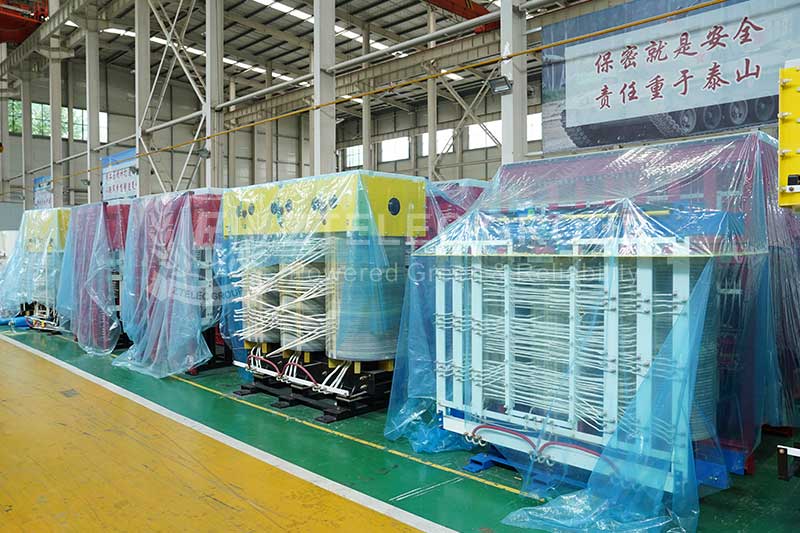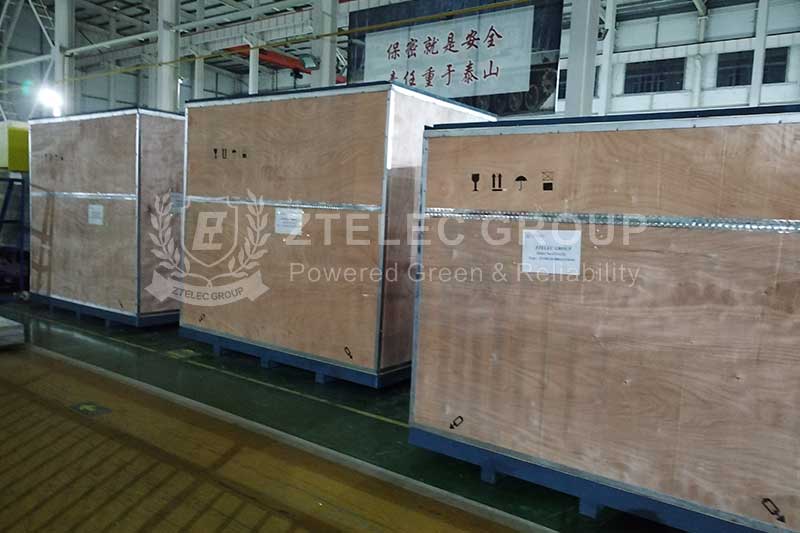The shunt capacitor for compensation is most sensitive to harmonic voltage, and the harmonic voltage accelerates the aging of the capacitor and shortens the service life. The harmonic current will overload the capacitor and cause an unacceptable temperature rise. Especially when the capacitor bank and the system generate parallel resonance, the current increases rapidly, the switch trips, the fuse blows, and the capacitor cannot operate. In order to avoid the occurrence of parallel resonance, the capacitor is connected in series with the reactor. Its reactance rate is selected according to the number of background harmonics. When the harmonics of the power grid are 5 times or more, 4.5% ~ 6% should be selected. When the background harmonic of the power grid is 3 times or more, 12% should be selected.

First, the determination of the K value of the reactance rate
1. There are few harmonics in the system, just select K=0.5~1% to meet the requirements when limiting the inrush current. It is a serious amplification of the 5th harmonic current and a slight amplification of the 3rd harmonic.
2. When the harmonics in the system can not be ignored, the background harmonic content of the power supply system should be ascertained, and the K value should be determined reasonably. The reactance rate should be configured so that the harmonic impedance of the capacitor is sensitive. When the grid background harmonic is 5 times or more, K=4.5~6% should be configured. Usually the 5th harmonic is the largest, the 7th harmonic is the second, and the 3rd is smaller. K=4.5~6% is usually used at home and abroad. It is good to configure the K=6% reactor to suppress the 5th harmonic, but the obvious 3rd harmonic and the resonance point are 204Hz, and the frequency of the 5th harmonic is 250Hz, and the margin is large. The 4.5% reactor is configured to slightly amplify the 3rd harmonic, so it is appropriate to suppress the harmonics of 5th and above, and at the same time reduce the amplification of the 3rd harmonic. Its resonance point is smaller between the 235Hz and the 5th harmonic. When the grid background harmonic is 3 times or more, K=12% reactor should be connected in series. In the series circuit of the reactor capacitor, the inductive reactance XLN of the reactor is proportional to the harmonic order of the number of harmonics; the capacitive reactance of the capacitor XCN is inversely proportional to the number of harmonics. In order to suppress harmonics of 5 times and above. Then, the number of resonances of the harmonic circuit of the 5th and above harmonics is less than 5 times. Thus, for the harmonics of 5 times and above, the series circuit of the electric capacitor is inductive, which eliminates the generation condition of the parallel resonance; for the fundamental wave, the series circuit of the reactor capacitor is capacitive and maintains the reactive power compensation function. If the series circuit of the reactor capacitor resonates under the nth harmonic, then:

In the formula, XCN/XLN is the reciprocal of the reactance rate, and different reactance rates correspond to different resonance times or different resonance frequencies, as shown in Table 1. The reactance of the reactor is preferably 6%, which avoids resonance of the 5th harmonic due to manufacturing errors of the reactor or capacitor or changes in parameters during operation. If the capacitor is connected, the power grid is seriously polluted, and the reactance rate must be calculated separately.

Based on the current I, the voltage drop ULN on the reactor leads the current by 90°, and the system voltage UXN is the vector sum of both: UXN=UCN-ULN. If the reactance of the reactor is 6%, then:
ULN=0.06UCN
UXN=(1-0.06)UCN
After the capacitor has a series reactance of 6% reactor, the capacitor terminal voltage is 1.064 times the grid voltage.
After the series reactor, the current will also increase, the reactance rate is K=6%, and the capacitor terminal voltage is 1.064 times the grid voltage, and the current is also increased to the same multiple. Does the reactive power compensation capacity increase or decrease? An increase in the voltage at the capacitor terminal will undoubtedly increase the reactive power compensation capacity.
(1) Capacitor reactive power compensation capacity Q’C
Q’C=(UCN/ UXN)2QC=(1.064UXN/UXN)2
Q’C=1.13QC
(2) Reactor consumes capacitive reactive power QL
QL=3I2XLN=3(1.064 UXN/UXN)2(0.06 XCN)=1.0642×0.06×(3U2XN/ XCN)=0.068QC (3) Actual reactive power compensation capacity:
Q’C- QL=(1.13-0.068) QC=1.062 QC
From the above equation, after the capacitor series reactor, the reactive power compensation has not decreased, but increased by 6.2%.
Second, the installation position of the reactor
The series reactor is the same in terms of limiting the inrush current and suppressing harmonics, whether it is mounted on the power supply side or the neutral point side. When the reactor is installed on the power supply side, the operating conditions are harsh. Because it is subjected to the impact of short-circuit current, the ground voltage is also high (relative to the neutral point), so the dynamic and thermal stability is high, and the core reactor has iron core saturation. .
When the reactor is installed on the neutral point side, the reactor requirements are relatively low, and generally it is not affected by the short-circuit current. There is no special requirement for dynamic and thermal stability, and the voltage to the ground is low. It can be seen that it lacks the ability of the reactor to withstand short-circuit current surges than when installed on the power supply side.
Third, the structure of the reactor
The structure of the reactor mainly has two structures of hollow core and iron core.
The main advantages of the core structure reactor are: low loss, good electromagnetic compatibility, and small size. The disadvantage is: there is noise and the core saturation loses the current limiting capability when the accident current is large. When the dry iron core and the reactor made of oxygen resin cast coil have good dynamic and thermal stability, it is suitable for being installed in the cabinet. Although the oil-immersed iron core reactor is larger in size, it has less noise, better heat dissipation and convenient installation, and is suitable for outdoor use.
The main advantages of the air core reactor are: good linearity, strong ability to limit short-circuit current and low noise. The disadvantages are: large loss and large volume. This kind of reactor is suitable for outdoor use, but it is not suitable for being installed in the cabinet. Installation outdoors can easily solve the problem of electromagnetic induction. It is best to use a phase separation "good" or "one" shape. This distance between the phases helps to prevent phase-to-phase short circuits and narrow the scope of the accident. So this arrangement is preferred. When the site is restricted and cannot be separated by phase, stacked products can be used. The winding direction of the B-phase coil of the three-phase stacked product is in the opposite direction to make the pillar insulation under pressure, so it must be installed according to the manufacturer's specifications.
Fourth, TSC dynamic reactive power compensation, it uses thyristor switch (zero-crossing trigger), cast power capacitor group to achieve reactive power compensation. Effectively improve the power factor of the power load, with significant energy saving effect. The series reactor is used in the TSC system, which can effectively prevent harmonic amplification and effectively absorb most harmonic currents.

The core component is the controller. Based on the signal processor DSP and VLSI circuit, all the data are analyzed in each grid cycle within 1ms. The required reactive compensation technology is calculated. The harmonic components of all phases are calculated at the same time, and the trigger signal is issued to ensure 5~20ms switching capacitor bank, AR type string 7% reactor (balance compensation system), or 14% reactor (unbalance compensation system) to prevent 5th and 3rd harmonic parallel connection between capacitor bank and power grid resonance. Most of the spot welding equipment in the automotive industry uses 380V power supply, which is powered by two phases (L1—L2, L2—L3 or L3—L1). Usually, the balance problem of three-phase load has been considered in the power supply design of the factory. The power supply layout of the machine is close to balance, avoiding zero-sequence current due to three-phase unbalance, so in this case, three-phase balance is usually used. See the relevant information of several big car companies in Europe and America. When the power imbalance of the spot welding machine is less than 20%, it is not harmful to use the reactive power balance compensation for the power supply network. When the imbalance is more than 20%, it should be considered. Unbalance compensation
ZTELEC produces high quality series reactors to suppress harmonics.












Leave A Comment